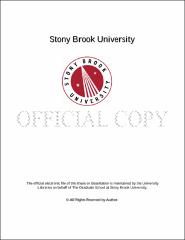| dc.identifier.uri | http://hdl.handle.net/11401/76696 | |
| dc.description.sponsorship | This work is sponsored by the Stony Brook University Graduate School in compliance with the requirements for completion of degree. | en_US |
| dc.format | Monograph | |
| dc.format.medium | Electronic Resource | en_US |
| dc.language.iso | en_US | |
| dc.publisher | The Graduate School, Stony Brook University: Stony Brook, NY. | |
| dc.type | Dissertation | |
| dcterms.abstract | The use of optical forces to precisely control the motion of atoms has played a major role in expanding the field of atomic physics. However, in a majority of experiments, these optical forces are limited in strength by the inherent properties of the chosen atoms, mainly the rates of spontaneous emission, required to return the atoms to their ground state. It has been shown that the process of absorption, followed by stimulated-emission, can be used to provide a more rapid return to the atomic ground state. Through careful design of the experiment, a coherent exchange of momentum can take place, exerting a large force on the atoms. Adiabatic Rapid Passage (ARP) is a technique commonly used in the magnetic resonance community for the population inversion of a two-level spin system. This technique has been expanded to the optical regime and used to invert the electronic states of an atomic system, allowing for control over both absorption and stimulated emission. It has been previously demonstrated that this scheme can be used to generate large forces on stationary atoms. An in-depth study of this ARP force will be presented with a strong emphasis on experiments designed to measure the dependence of the ARP force on atomic velocity. The experiments use the $2^3S\rightarrow2^3P$ transition in Helium at $\lambda=1.083\unit{\um}$, and results show, that by using a properly-tailored pulse sequence, the ARP force can exerts a large force on atoms over a large velocity range, making it a potential candidate to decelerate neutral atomic (or molecular) beams Numerical simulations of multiple ARP processes on two-level atoms were run with the hopes of gaining further insight into the subsequent force. These simulations have unveiled some interesting questions about the ARP process. These questions pertain to spontaneous emission's effect on the force and the influence of the phase of the optical pulses on the atomic state. While the simulations exhibit some overall similarities with the experimental results quantitative agreement is generally poor. Explanation for this disagreement is presented along with a roadmap for future work. | |
| dcterms.available | 2017-09-20T16:51:00Z | |
| dcterms.contributor | Dawber, Matthew | en_US |
| dcterms.contributor | Metcalf, Harold J | en_US |
| dcterms.contributor | Wei, Tzu-Chieh | en_US |
| dcterms.contributor | Sears, Trevor. | en_US |
| dcterms.creator | Elgin, John David | |
| dcterms.dateAccepted | 2017-09-20T16:51:00Z | |
| dcterms.dateSubmitted | 2017-09-20T16:51:00Z | |
| dcterms.description | Department of Physics. | en_US |
| dcterms.extent | 91 pg. | en_US |
| dcterms.format | Monograph | |
| dcterms.format | Application/PDF | en_US |
| dcterms.identifier | http://hdl.handle.net/11401/76696 | |
| dcterms.issued | 2015-12-01 | |
| dcterms.language | en_US | |
| dcterms.provenance | Made available in DSpace on 2017-09-20T16:51:00Z (GMT). No. of bitstreams: 1
Elgin_grad.sunysb_0771E_12466.pdf: 24742421 bytes, checksum: 9064793c9dc7f8d6ea899747e57083e0 (MD5)
Previous issue date: 1 | en |
| dcterms.publisher | The Graduate School, Stony Brook University: Stony Brook, NY. | |
| dcterms.subject | Adiabatic Rapid Passage, ARP, Optical Forces, Stimulated Optical Forces | |
| dcterms.subject | Physics | |
| dcterms.title | Study of the Velocity Dependence of the Adiabatic Rapid Passage (ARP) Optical Force in Helium | |
| dcterms.type | Dissertation | |

